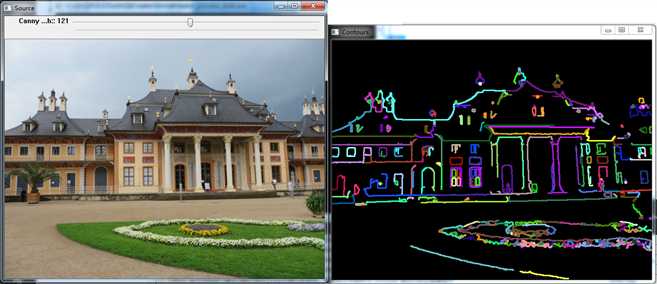标签:drawing 32位 strong include git char sde simple val
1 基于阈值
1.1 基本原理
灰度阈值化,是最简单也是速度最快的一种图像分割方法,广泛应用在硬件图像处理领域 (例如,基于 FPGA 的实时图像处理)。
假设输入图像为 f,输出图像为 g,则经过阈值化处理的公式如下:
$\quad g(i, j) = \begin{cases} 1 & \text{当 f(i, j) ≥ T 时} \\0 & \text{当 f(i, j) < T 时} \\ \end{cases} $
也即,遍历图像中的所有像素,当像素值 f (i, j) ≥ T 时,分割后的图像元素 g (i, j) 是物体像素,否则为背景像素。
如果各个物体之间彼此不接触,并且物体灰度和背景灰度之间差别比较明显时,灰度阈值化便是非常合适的分割方法。
1.2 cv::threshold 函数
OpenCV 中的阈值化函数为 threshold,其使用如下所示:
double cv::threshold ( InputArray src, // 输入图像 (单通道,8位或32位浮点型) OutputArray dst, // 输出图像 (大小和类型,都同输入) double thresh, // 阈值 double maxval, // 最大灰度值(使用 THRESH_BINARY 和 THRESH_BINARY_INV类型时) int type // 阈值化类型(THRESH_BINARY, THRESH_BINARY_INV; THRESH_TRUNC; THRESH_TOZERO, THRESH_TOZERO_INV) )
1) THRESH_BINARY
$\qquad dst(x, y) = \begin{cases} maxval & \text{if src(x, y) > thresh} \\0 & \text{otherwise} \\ \end{cases} $
2) THRESH_TRUNC
$\qquad dst(x, y) = \begin{cases} threshold & \text{if src(x, y) > thresh} \\src(x, y) & \text{otherwise} \\ \end{cases} $
3) THRESH_TOZERO
$\qquad dst(x, y) = \begin{cases} src(x, y) & \text{if src(x, y) > thresh} \\0 & \text{otherwise} \\ \end{cases} $
1.3 示例
下面是阈值化类型和阈值可选的代码示例,摘自 OpenCV 例程,略作修改
#include "opencv2/imgproc.hpp" #include "opencv2/imgcodecs.hpp" #include "opencv2/highgui.hpp" using namespace cv; int threshold_value = 0; int threshold_type = 3; int const max_value = 255; int const max_type = 4; int const max_BINARY_value = 255; Mat src, src_gray, dst; const char* window_name = "Threshold Demo"; const char* trackbar_type = "Type: \n 0: Binary \n 1: Binary Inverted \n 2: Truncate \n 3: To Zero \n 4: To Zero Inverted"; const char* trackbar_value = "Value"; void Threshold_Demo(int, void*); int main( int, char** argv ) { // 读图 src = imread("Musikhaus.jpg",IMREAD_COLOR); if( src.empty() ) return -1; // 转化为灰度图 cvtColor( src, src_gray, COLOR_BGR2GRAY ); // 显示窗口 namedWindow( window_name, WINDOW_AUTOSIZE ); // 滑动条 - 阈值化类型 createTrackbar( trackbar_type, window_name, &threshold_type,max_type,Threshold_Demo); // 滑动条 - 阈值 createTrackbar( trackbar_value,window_name, &threshold_value,max_value,Threshold_Demo); Threshold_Demo(0, 0); waitKey(0); } void Threshold_Demo(int, void*) { /* 0: Binary 1: Binary Inverted 2: Threshold Truncated 3: Threshold to Zero 4: Threshold to Zero Inverted */ threshold(src_gray, dst, threshold_value, max_BINARY_value, threshold_type); imshow(window_name, dst); }
2 基于边缘
前一篇 <OpenCV 之 边缘检测> 中,介绍了三种常用的边缘检测算子: Sobel, Laplace 和 Canny 算子。
实际上,边缘检测的结果是一个个的点,并不能作为图像分割的结果,必须采用进一步的处理,将边缘点沿着图像的边界连接起来,形成边缘链。
2.1 轮廓函数
OpenCV 中,可在图像的边缘检测之后,依次使用 cv::findContours 和 cv::drawContours 函数,寻找到轮廓并将其画出
void cv::findContours ( InputOutputArray image, // 源图像 OutputArrayOfArrays contours, // 检测到的轮廓 OutputArray hierarchy, // int mode, // 轮廓获取模式 (RETR_EXTERNAL, RETR_LIST, RETR_CCOMP,RETR_TREE, RETR_FLOODFILL) int method, // 轮廓近似算法 (CHAIN_APPROX_NONE, CHAIN_APPROX_SIMPLE, CHAIN_APPROX_TC89_L1, CHAIN_APPROX_TC89_KCOS) Point offset = Point() // 轮廓偏移量 )
cv::drawContours 函数各参数如下:
void cv::drawContours ( InputOutputArray image, // 目标图像 InputArrayOfArrays contours, // 所有的输入轮廓 int contourIdx, // const Scalar & color, // 轮廓颜色 int thickness = 1, // 轮廓线厚度 int lineType = LINE_8, // InputArray hierarchy = noArray(), // int maxLevel = INT_MAX, // Point offset = Point() // )
2.2 例程
代码摘自 OpenCV 例程,略有修改
#include "opencv2/imgcodecs.hpp" #include "opencv2/highgui.hpp" #include "opencv2/imgproc.hpp" using namespace cv; using namespace std; Mat src,src_gray; int thresh = 100; int max_thresh = 255; RNG rng(12345); void thresh_callback(int, void* ); int main( int, char** argv ) { // 读图 src = imread("Pillnitz.jpg", IMREAD_COLOR); if (src.empty()) return -1; // 转化为灰度图 cvtColor(src, src_gray, COLOR_BGR2GRAY ); blur(src_gray, src_gray, Size(3,3) ); // 显示 namedWindow("Source", WINDOW_AUTOSIZE ); imshow( "Source", src ); // 滑动条 createTrackbar("Canny thresh:", "Source", &thresh, max_thresh, thresh_callback ); // 回调函数 thresh_callback( 0, 0 ); waitKey(0); } // 回调函数 void thresh_callback(int, void* ) { Mat canny_output; vector<vector<Point> > contours; vector<Vec4i> hierarchy; // canny 边缘检测 Canny(src_gray, canny_output, thresh, thresh*2, 3); // 寻找轮廓 findContours( canny_output, contours, hierarchy, RETR_TREE, CHAIN_APPROX_SIMPLE, Point(0, 0) ); Mat drawing = Mat::zeros( canny_output.size(), CV_8UC3); // 画出轮廓 for( size_t i = 0; i< contours.size(); i++ ) { Scalar color = Scalar( rng.uniform(0, 255), rng.uniform(0,255), rng.uniform(0,255) ); drawContours( drawing, contours, (int)i, color, 2, 8, hierarchy, 0, Point() ); } namedWindow( "Contours", WINDOW_AUTOSIZE ); imshow( "Contours", drawing ); }
以 Dresden 的 Schloss Pillnitz 为源图,输出如下:

参考资料:
OpenCV Tutorials, imgproc module, Basic Thresholding Operations
OpenCV Tutorials, imgproc module, Finding contours in your image
<图像处理、分析与机器视觉_第3版> 第 6 章
Topological structural analysis of digitized binary images by border following [J], Satoshi Suzuki, 1985
标签:drawing 32位 strong include git char sde simple val
原文地址:http://www.cnblogs.com/xinxue/p/5350746.html